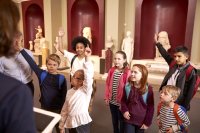Asking Students to Plan Bad Behavior
Getting students to think about behaving badly helps them arrive at positive norms—and such reverse thinking may work in other situations as well.
Your content has been saved!
Go to My Saved Content.Here’s a question students don’t expect to hear from a teacher: “How can we make sure to get kicked out of the museum today?”
It was Tuesday morning, and my fifth grade class was getting ready to go on a field trip to the Honolulu Museum of Art. While I relish every chance I get to visit museums, I sensed that a few of my students did not feel the same way.
I had to make a choice before our departure: Review the safety rules and run the risk of seeing their eyes glaze over, or engage the students in coming up with appropriate behavior expectations for themselves.
How? By inviting them to first think about inappropriate behavior—that is, we used reverse thinking. My hope, of course, was that students would be fully engaged in the museum learning experience, and I thought I could increase their engagement by encouraging them to imagine purposefully misbehaving in that public space.
At first, there was silence. My students just stared at me, thinking that I had misspoken. They waited for me to correct myself. I didn’t—instead I convinced them that such absurdity was deliberate. The once unenthusiastic students now wore mischievous smiles.
On Not Getting Kicked Out of a Museum
One student raised his hand and yelled, “Touch everything on display!” Another student chimed in, “We can talk really loud!” Yet another exclaimed, “Run laps around the entire gallery!”
Some students were more detailed in their schemes. One student said, “We could sneak in through the back door and shut off the power to the entire museum!” The class roared with laughter as they imagined how they would pull off such a stunt. I knew then that they were hooked and invested in our discussion.
The next step was to have students consider the layers of rationale behind their ideas. For example, I asked the first student why touching everything on display would get us kicked out. He responded that the art would get dirty, and added that the art might change colors because of the oils on people’s hands.
I pushed him to consider that from the perspective of the museum. Why would the dirtiness or color change be reasonable cause to force our exit? After some thought, he said that other people wouldn’t be able to enjoy the art, which would defeat the purpose of a museum.
When I asked him how we could prevent this problem from happening, he simply replied, “Don’t touch the art.” I encouraged him to come up with a more specific strategy to achieve this, and he answered, “We can put both of our hands behind us when we look at an artwork.”
The discussion continued, and soon the students had covered all of the points I wanted to cover. Our reverse thinking exercise proved to be powerful, as I noticed students exhibiting positive behavior throughout the field trip—and the very students who prompted me to try reverse thinking in the first place were the ones reminding their peers to be respectful and referring back to our discussion.
Applying This Idea in Other Areas
As I reflected on the positive impact reverse thinking had on my students, I began to wonder about its application in core content areas. For example:
- How can we confuse our reader with our writing?
- How do we create the worst science fair experiment ever?
- What might help us give up on a math problem solving task?
The beauty of reverse thinking is that it can captivate and engage even the most cynical and apathetic students. More importantly, it can help students honestly identify challenges, explore potential causes of those challenges, and develop creative strategies or solutions.
With careful guidance, reverse thinking can be a tremendously enjoyable process as students actively transform their most frequent mistakes into a meaningful opportunity of analysis and reflection.
Looking at things from a different angle might be what students are craving. We must be creative in seeking to build an intellectual environment that stimulates and activates student thinking. Reverse thinking is one way to start a discussion.
